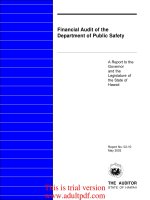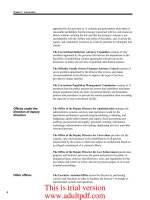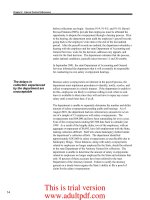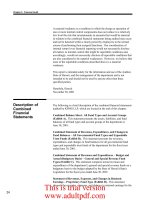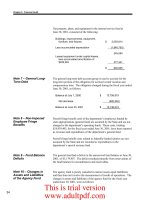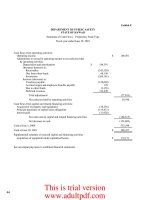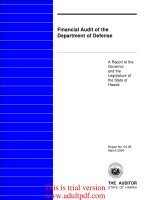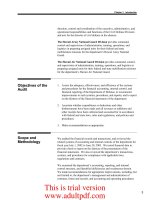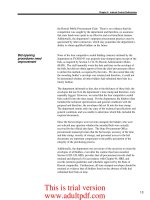Financial Audit of the Department of Agriculture A Report to the Governor and the Legislature of the State of Hawai`i Report No. 05-02 April 2005_part3 pdf
Bạn đang xem bản rút gọn của tài liệu. Xem và tải ngay bản đầy đủ của tài liệu tại đây (47.86 KB, 11 trang )
Chapter 2: Internal Control Deficiencies
Internal records are not
reconciled to FAMIS on
a monthly basis
The division’s APPX system is capable of producing various monthly
reports. We found that these reports are not reconciled to the
Financial Accounting and Management Information System (FAMIS)
reports produced by the Department of Accounting and General
Services on a monthly basis.
Monthly reconciliations are measures to detect improprieties in
financial data. When reconciliations are performed monthly,
corrections can be made on a timely basis. Untimely reconciliations
make it more difficult to resolve any discrepancies that arise. In some
extreme cases, reconciliations may help to uncover fraud schemes.
Once again, no policies are in place to require monthly reconciliations
and corresponding reviews of division and FAMIS reports.
Consequently, division personnel perform reconciliations only at the
end of the fiscal year.
Participation loans are
not adequately
documented
A participation loan is a loan in which both the department and a private
lender provide funds and have a proportionate share of interest in the
loan. As of June 30, 2004, the department participated in 16 loans with
various Hawai`i financial institutions with a principal balance due solely
to the department totaling approximately $1.2 million. We found that
although the loan files contained basic participation agreements, there
was no other evidence that the division loan officers were monitoring the
private lenders for compliance with applicable statutes.
Participation agreements with private lenders stipulate that the
participating institutions are responsible for administering the loans and
ensuring compliance with statutes and rules. This, in effect, puts the
private institutions in the same position as that of the department.
Monitoring of these loans in particular is essential as private institutions
may not be familiar with the intricacies of applicable state laws and
regulations. There are no formal monitoring procedures in place to
determine whether rules are being adhered to. Currently, division loan
officers rely on phone calls and email correspondence to stay current
with private lenders. This finding was reported in a prior audit.
Recommendations
We recommend that the department:
•
14
Be more diligent in obtaining required loan documents and
ensure that the required documents are reviewed and signed off
by appropriate personnel. In cases where unsuccessful requests
have been made to obtain documents from borrowers, all
correspondence should be retained in the respective loan files;
This is trial version
www.adultpdf.com
Chapter 2: Internal Control Deficiencies
•
Prepare monthly delinquent loan status memos on a timely
basis. Also, to assist in the timely preparation of these memos,
monthly delinquent loan reports should be distributed to the loan
officers within the first ten working days of each month;
•
Revise the policies and procedures manual to incorporate
minimum collection procedures on delinquent loans;
•
Retain adequate documentation to provide evidence that
collection attempts have been made on delinquent loans. These
may include collection letters, email and telephone memos,
checklists, and other documents deemed necessary. A collection
attempt history form may be developed to standardize the
documentation of collection attempts. Also, the department
should revise its policies and procedures manual to incorporate
requirements for sufficient documentation regarding collection
attempts;
•
Perform initial and subsequent on-farm visits as required by
division policy. Documentation should be made on division loan
servicing reports. A tickler system, used by many as a reminder
for critical upcoming dates, may be devised to track dates for
subsequent on-farm visits;
•
Obtain supervisory reviews when new loan account information
is entered into the loan master file. Evidence of this review
should be documented on the loan document checklist, with a
separate sign-off for this particular item. Also, the department
should revise the policies and procedures manual to incorporate
supervisory review requirements;
•
Obtain reviews for transaction journals that provide support for
bank deposit slips. Additionally, journals should be initialed for
evidence of reviews. At minimum, monthly, reconciled cash
receipt journals should be obtained from the department’s fiscal
office and reconciled to monthly division transaction journals;
•
Delegate approvals for changes to loan account information to
someone other than the person making the changes to loan
master files. Revise policies and procedures manual to include
duties and responsibilities for positions within the division;
•
Update the APPX system manual to incorporate the following:
o
Program documentation, with data file layouts clearly
differentiating applications changes;
This is trial version
www.adultpdf.com
15
Chapter 2: Internal Control Deficiencies
o
Operations documentation, describing the job stream flow,
error messages, operator actions, data control procedures,
and any special end of month or end of year procedures; and
o
User documentation, supplementing application menus
with narrative as required;
•
•
The
Methodologies
Used to Determine
the Allowance for
Loan Losses and
to Recognize
Interest on
Delinquent Loans
Are Not in
Accordance with
Generally
Accepted
Accounting
Principles
16
Reconcile division records to FAMIS reports on a monthly
basis. Journal vouchers should be prepared to balance FAMIS
and division reports; and
Update the policies and procedures manual to include procedures
on determining whether private lenders are in compliance with
applicable laws regarding participation loans. Steps taken to
determine compliance should be adequately documented within
the loan files.
The Agricultural Loan Division is responsible for the administration of
its loan program. This includes the analysis of the collectibility of
each loan and the determination of an adequate allowance for loan
losses (allowance). The allowance represents management’s best
estimate of the uncollectible portion of all outstanding loans at a given
point in time. An adequate allowance is essential for the department
because of the high risks involved in providing loans under its
program. Such risks include credit, environmental, and concentration
risk. Credit risk arises because potential borrowers approach the
department only as a last resort and only after the borrowers have
obtained at least two letters of turndown from private financial
institutions. The agricultural sector presents an environmental risk
because of its vulnerability to natural disasters, most notably flooding
and periods of drought conditions. Concentration risk is due to the
department issuing one primary type of loan.
The department’s total loan receivable balance and initial related
allowance as shown on the financial statements as of June 30, 2004,
was $22,755,368 and $1,751,845, respectively. Since management
determines the allowance based on subjective as well as objective
factors, judgment is often required to estimate the amount shown on
the financial statements. Management’s judgment should be based on
its knowledge and experience about past and current events and
assumptions about current conditions, with respect to individual loans,
the entire loan portfolio, and the State’s economy. Accounting
principles generally accepted in the United States of America require
This is trial version
www.adultpdf.com
Chapter 2: Internal Control Deficiencies
that the allowance be reasonable and supported by relevant
information and adequate documentation. However, the department’s
allowance does not meet any of these requirements.
Additionally, the department improperly accrues interest income on
loans greater than 90 days delinquent in the Financial Assistance for
Agriculture Fund. Generally accepted accounting principals require
that interest on loans should be recognized when it becomes both
measurable and available to finance expenditures of the fiscal period;
however, the department continued to accrue interest on these
delinquent loans despite a lack of availability.
The allowance for loan
losses has no
adequate basis
Management considers a loan to be delinquent if payment is not
received within 30 days after the due date. At June 30, 2004, there
were 64 past due loan accounts totaling $835,347 in overdue principal,
of which $696,405, or 83 percent, had been outstanding for greater
than one year. These 64 delinquent accounts also had a related
accrued interest balance of $514,112.
The department’s methodology in determining the allowance is faulty.
In general, management considers a loan seriously delinquent at 180
days past due. At this point, it is the division’s policy to submit the
account to the Board of Agriculture for approval to forward the
account to the Department of the Attorney General for further
collection attempts and, if necessary, disposition. When all attempts at
collection by the Department of the Attorney General are exhausted,
the file is returned to the department for write-off. Only at this point is
the loan considered an estimated uncollectible and added to the
allowance for loan losses. This treatment contradicts the very purpose
of an allowance – to estimate probable future losses. Loans at this
stage are actual losses and should simply be written-off and removed
from the department’s books. Moreover, we noted the department has
not written-off any loans since November 2000.
The allowance is not
supported by sufficient
documentation
For the year ending June 30, 2004, the department's initial allowance
as adjusted by its contract auditors was $1,751,845, which is
approximately $995,000 greater than the amount calculated by
department personnel. Those personnel could not provide adequate
information and documentation of their methodology in determining
either amount, making it impossible to obtain sufficient evidential
matter for its allowance account balalnce. Therefore, we initially were
unable to determine the adequacy of the allowance account and the
accuracy of the financial statements. However, subsequent to our
initial review, the department recorded an additional adjustment to
increase their allowance for loan losses to $2 million, approximately
This is trial version
www.adultpdf.com
17
Chapter 2: Internal Control Deficiencies
$1,243,000 greater than the department's original internal calculation.
We further noted that the analyses and calculations of the allowance is
performed only at fiscal year end. Because of the volatility of the
agricultural sector, the ability of farmers to repay their loans is
susceptible to many, sometimes uncontrollable, factors throughout the
year. The allowance should be analyzed monthly and used to monitor
the status of the loan portfolio.
Failure to properly value the allowance for loan losses may result in
improper financial reporting and misrepresents the abilities of the
farmers to repay their loans. The underlying cause of this deficiency is
a lack of policies and procedures that establish sound methodology for
determining the allowance for loan losses. The significance of this
finding, if uncorrected, would have led to a "qualified opinion" on the
fairness of the department's June 30, 2004 financial statements as it
relates to the allowance for loan losses. Further, we noted that
although the Board of Agriculture is involved in loan approvals and
write-offs, it is not familiar with the ongoing status of loans. The
board has a fiduciary responsibility for taxpayer money and cannot
execute this responsibility without knowing the condition of its $22
million in outstanding agricultural loans. As "policy directors," the
board should be more involved in the operations of its loan program
and more informed about the health of the entire loan portfolio.
Interest on loans is
accrued beyond its
measurable and
available period
Interest revenues on loans in the Financial Assistance for Agriculture
Fund should be recognized in the accounting period that they become
susceptible to accrual. In applying the susceptibility to accrual
concept, management should utilize their judgment, and should
consider its materiality and consistency of application in determining
when revenues become both measurable and available to finance
expenditures of the fiscal period. The key element is the availability
concept, which is generally held to mean collectible within the current
period or soon enough thereafter to be used to pay liabilities of the
current period.
We found that the department continues to accrue interest on loans
with interest greater than 90 days past due, the point at which revenues
are no longer available to finance current period expenditures. The
department’s accrued interest receivable on loans greater than 90 days
delinquent as of June 30, 2004, is $468,000. In one instance, we found
that a single loan with a principal balance of $56,900 had accrued
interest totaling $86,000 at June 30, 2004. Continued accrual of
interest beyond its measurable and available period is a violation of
generally accepted accounting principles. Furthermore, it overstates
both the department’s loan portfolio and the interest recognized on the
statement of revenues, expenditures, and changes in fund balances.
18
This is trial version
www.adultpdf.com
Chapter 2: Internal Control Deficiencies
We recommend the following measures regarding the allowance for
loan losses:
•
Calculate and review the allowance with competent and welltrained personnel;
•
Document the calculation, including a detailed analysis,
considering all internal and external factors and based on current
and reliable data;
•
Implement a comprehensive loan monitoring process, complete
with monthly analysis and a loan "watch" list. A loan watch list
is a listing of loans of particular interest to the department. This
could be based on quantitative (large outstanding balance) as
well as qualitative (delinquency status, borrowers with more
than one outstanding loan) factors. This list should include the
borrower’s name, outstanding loan balance, collateral value,
financial information summary, loss exposure, and any other
comments as to performance forecast. This will give the loan
administrator and the board a snapshot of the health of the loan
portfolio and any possible future issues;
•
Require the Board of Agriculture to be more involved with the
loan program by reviewing delinquency reports and watch lists,
establishing and updating policies and procedures, and issuing
recommendations to the division when necessary; and
•
The Department’s
Management of Its
Accounts
Receivables Is
Ineffective
Expand the division’s policies and procedures manual to
incorporate a methodology to determine a reasonable and
adequate allowance in accordance with generally accepted
accounting principles;
•
Recommendations
Discontinue the accrual of interest on loans with interest greater
than 90 days delinquent in the Financial Assistance for
Agriculture Fund.
The department’s total accounts receivables have increased over the
last three years by an average of $513,398, as illustrated by Exhibit
2.2, despite an average decrease in charges for services of $307,264
during the same period. This trend represents a significant problem
and indicates the department’s need to more effectively manage and
control its accounts receivables. In particular, at the Animal
Quarantine Station and the Agriculture Resource Management
Division, which together comprise 89 percent of the department’s total
receivables, the department has failed to establish clear policies over
This is trial version
www.adultpdf.com
19
Chapter 2: Internal Control Deficiencies
the performance and documentation of monitoring and collection
efforts on delinquent accounts. Further, the department has not
established and communicated adequate organization-wide policies for
the disposition of uncollectible accounts and setting up related
allowances.
The Animal Quarantine
Station’s collection
procedures are
inadequate
The primary purpose of the quarantine station is to keep Hawai`i a
rabies free state. Each pet owner is required to remit a quarantine fee
depending on the expected length of a pet’s stay at the station. As an
alternative, a promissory note may be signed to assist residents,
visitors, and military families with their financial obligation.
Departmental records show the number of pets that entered the
quarantine system during the years ended June 30, 2003 and 2004, as
5,440 and 7,276, respectively, an increase of 1,836 pets. However,
receipts collected at the quarantine station totaled $3.12 million and
$2.24 million for the years ended June 30, 2003 and 2004,
respectively, a decrease of $880,000.
According to the department’s aging report, the station’s total
receivable balance as of June 30, 2004, was approximately $1.1
million, of which approximately $865,000, or 77 percent, was three
months or more past due. Exhibit 2.1 illustrates the aging
breakdown. This alarmingly large percentage highlights the need for
better account maintenance and collection procedures.
Exhibit 2.1
Animal Quarantine Station accounts receivable at June
30, 2004
Accounts
receivables days
outstanding
Current
31 – 90 days
91 – 360 days
1 year +
Totals
Amount
outstanding
$ 135,194
122,631
366,132
498,796
$1,122,753
Percentage
of total
12%
11%
33%
44%
100%
Current
12%
31 - 90 days
11%
1 year +
44%
91 - 360 days
33%
Source: June 30, 2004 Animal Quarantine Station aging report
20
This is trial version
www.adultpdf.com
Chapter 2: Internal Control Deficiencies
For its delinquent accounts, we found that the quarantine station sends
past due notices but does not follow up if the notices do not result in
collection. During a site visit to the station, we noted that a copy of the
policies and procedures was not available and customer files were
difficult to locate. Also, personnel were not aware that accounts
should be referred to a collection agency after 30 days from the date of
a final notice, as required by station policy. After two years, the
account is to be submitted to the Board of Agriculture and the
Department of the Attorney General for disposition. As of June 30,
2004, the balance of receivables over two years old was approximately
$303,000, or 27 percent of the total balance. Furthermore, there are no
policies and procedures dictating how to remove accounts from the
station’s internal system after approval for disposition.
The Animal Quarantine brochure issued by the department and made
available to the general public clearly states that all fees must be paid
before release of the pet. This statement contradicts the receivable
balance on the books. If payment is required to release a pet, there
should be a minimal balance, if any, on the department’s records.
Some remaining balances may be due to abandonment or death of the
pet while still in quarantine.
Departmental personnel have indicated that the problem is due to
recent high turnover in the clerical position at the station. They are
currently in the process of analyzing all accounts to determine whether
there are valid receivables. Department personnel believe that some
payments were inadvertently misposted to wrong accounts during the
past year as a result of new personnel who were unfamiliar with the
system.
The Agriculture
Resource Management
Division does not
adhere to, or document
efforts related to,
collection policies
The Agriculture Resource Management Division manages leased lands
and irrigation water usage at various agricultural lots throughout the
state via its agricultural park program. This program seeks to
encourage competition within the agricultural industry by providing
affordable irrigation water and farmland. At the division,
approximately $507,000, or 86 percent, of the $592,000 total
receivable balance is over three months old. Similar to the Animal
Quarantine Station, except for sending past due notices, the division
does not adhere to its policies regarding collection attempts. Based on
the severity of the delinquency, the division’s policies over collection
methods include late notices, collection letters, telephone calls, and
field visits. Division personnel are aware of the policies and
procedures; however, there were no indications of telephone calls or
subsequent actions that are to be taken as required by those policies
and procedures. The program manager maintains that many of the
substantial delinquent accounts as of the fiscal year ended June 30,
This is trial version
www.adultpdf.com
21
Chapter 2: Internal Control Deficiencies
2004, have made considerable payments, are in the process of being
granted work-out payment plans, or are in bankruptcy.
Failure by the division to properly manage its accounts receivables
deprives the State of realizing its earned revenues and may lead to
improper financial reporting as a result of unsupported allowance
accounts. Although the division’s collection guidelines are clearly
written, they are not fully adhered to and not sufficiently documented
within the customer files. Oversight over those policies forms the
basis for effective management practices. We feel improvement in
these areas for the Agriculture Resource Management Division will
lead to a higher collection rate for its accounts receivables.
The allowance for
doubtful accounts is
not supported by
sufficient
documentation
The department’s financial statements present receivable balances in
the aggregate, with the majority being comprised of the balances of the
Animal Quarantine Station and Agriculture Resource Management
Division. Exhibit 2.2 illustrates the department’s receivable balances
for FY2001-02 to FY2003-04.
Exhibit 2.2
Department of Agriculture accounts receivables
for FY2001-02 to FY2003-04
June 30,
2002
Average
annual
increase
$ 1,154,790
$ 843,131
$ 513,398
( 405,500)
$ 749,290
( 370,000)
$ 473,131
343,830
$ 169,568
June 30,
2004
Gross receivables
Less: Allowance for
doubtful accounts
Total net receivables
June 30,
2003
$ 1,869,927
( 1,057,659)
$ 812,268
Source: Department of Agriculture financial statements for FY2001-02 to FY2003-04
The allowance for doubtful accounts more than doubled from FY200203 to FY2003-04. Although this balance does not represent a
significant portion of the department's assets, it amounts to nearly 57
percent of total gross receivables at June 30, 2004. As it does with the
agricultural loans, the department relies heavily on its contract auditors
to determine the allowance for doubtful accounts reported in its
financial statements. Currently, all amounts over 90 days are included
in the allowance account.
Generally accepted accounting principles require that a sufficient
allowance be made to provide for potential losses and that this
calculation be adequately documented. The allowance should be based
on the department’s past experience, as well as other relevant and
22
This is trial version
www.adultpdf.com
Chapter 2: Internal Control Deficiencies
qualitative matters, and should not be limited to those accounts that are
90 days or more past due. Accounts less than 90 days past due should
also be considered for likelihood of collection.
Automatically assessing an account over 90 days as uncollectible may
lead to questions of whether the accounts were actually analyzed for
collectibility. Again, the underlying cause is a lack of policies and
procedures for determining an adequate allowance, as well as a lack of
understanding of applicable accounting guidelines.
Attempts to return
unclaimed money are
weak
When pets are admitted, the Animal Quarantine Station’s policy
requires fees to be collected on a prepaid basis for the estimated stay
of the pet. For example, a customer whose pet is estimated to stay 30
days will be required to pay the full 30 day rate upon entry. Although
written into policy, this is not always the case as the implementation of
promissory notes has created significant receivable balances. Some of
these pets with prepaid quarantine fees will be released prior to the 30
days, and a refund is posted to the system. Because the refund check
is processed through the Department of Accounting and General
Services, the money due cannot be refunded immediately. Situations
may arise, especially with military families passing through the
islands, in which the customer cannot be reached.
We found that 471 out of 2,859 accounts included credit balances due
to customers totaling approximately $46,000. Of this amount, 246
accounts totaling approximately $20,500 were aged greater than one
year. According to Chapter 523A, HRS, Unclaimed Property Act,
property not claimed by its rightful owners within five years is
presumed abandoned and shall be deposited into the State Treasury.
Efforts to return money should take on the same importance as efforts
to collect money. We did not find sufficient documentation within
customer files regarding refund efforts. In most cases, a simple note
was the only evidence of refund efforts. Failure to return money to its
rightful owners in a timely manner may raise questions as to the intent
of the animal quarantine program and the actual efforts of the
Statewide Unclaimed Property Section. Although not material to the
department’s gross receivables, the credit balances are netted against
the receivables, which results in understating the totals shown on the
aging reports.
This is trial version
www.adultpdf.com
23
Chapter 2: Internal Control Deficiencies
Recommendations
We recommend that the Animal Quarantine Station:
•
Consider discontinuing the use of promissory notes, as credit
cards are accepted;
•
Revise policies and procedures to include account write-offs and
determining adequate allowances;
•
Strengthen management oversight over delinquent accounts;
•
Refer delinquent accounts to a collection agency, the Board of
Agriculture, and the Department of the Attorney General for
timely disposition;
•
Strengthen efforts to return money due to customers and
document efforts taken within customer files. Provide better
training to new employees regarding the posting of customer
payments; and
•
Document collection and refund efforts using a standard form to
include customer name, contacts, nature, relevant dates, and a
history of efforts. This form should be maintained within
customer files.
We recommend that the Agricultural Resource Management Division:
•
•
Revise policies and procedures to include determining adequate
allowances; and
•
24
Document efforts within customer files using a standard form;
•
The Department’s
Year-End Financial
Reporting Process
Is Ineffective
Adhere to collection practices outlined in the policies and
procedures;
Refer delinquent accounts to a collection agency, the Board of
Agriculture, and the Department of the Attorney General for
timely disposition.
Accurate and timely financial reporting is a key factor in
management’s decision making. Management must have accurate and
timely financial information in order to measure an organization’s
performance, identify opportunities for improvement, and strategically
plan for the future. However, we noted significant deficiencies in the
department’s financial reporting process that hindered its ability to
produce timely year-end financial statements that are free from error.
This is trial version
www.adultpdf.com
